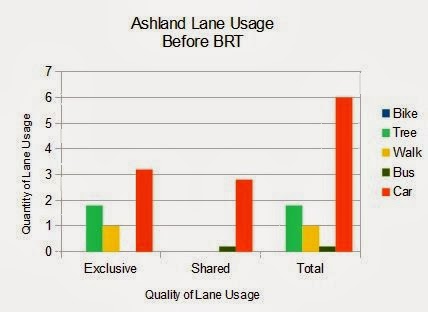Above is the current lane usage of Ashland Avenue. I am counting nine lanes of of possible street usage. There are two lanes of dedicated exclusive usage, one in each direction, for pedestrians and trees in the parkways on either side of the street. Bikes and cars and buses are denied usage of the sidewalks and therefore there is a half lane in each direction for the exclusive travel usage by pedestrians. Even though pedestrians are allowed to cross over the planted parkway I consider there to be two half lanes of dedicated exclusive usage for trees and plantings. In addition there is a median strip in the middle of Ashland that I have generously assigned 8/10s of a lane as dedicated to trees and plantings as well.
| Current Ashland Ave Lane Usage Assignments |
|
Bike |
Tree |
Walk |
Bus |
Car |
Total |
| Exclusive |
0 |
1.8 |
1 |
0 |
3.2 |
6 |
| Shared |
0 |
0 |
0 |
0.2 |
2.8 |
3 |
| Total |
0 |
1.8 |
1 |
0.2 |
6 |
9 |
|
|
|
|
|
|
|
Since buses effectively don't use the lane next to the median I assign that lane to exclusive use of cars. (And trucks which I treat like cars for the purposes of this analysis.) I also count the parking usage one either side of the street as two half lanes exclusive car usage. And further I assign two tenths of a lane in the median as exclusive lane for car turning. Again buses effectively do not use it. That's how I get 3.2 lanes of dedicated exclusive car lane usage.
Three lanes remain for shared usage for bikes, buses, and cars. Ashland is currently so hostile a street for biking that the effective rate of biking is less than one tenth a lane and I round their use down to zero usage. (Bikes would be dark blue if they showed up in the graph.)
I assume one bus per three blocks is sharing the road with either 99 cars or 97 cars for three blocks depending on whether we count the bus as one vehicle or three cars equivalent. In any case each bus uses less than one tenth a lane or two tenths for both directions rounded up to the next tenth of a lane in each direction. I believe that I am being generous with that calculation.
Is it fair that 30,000 daily users get two tenths of a lane while 50,000 [* see update at bottom] users get six lanes? It's a rhetorical question.
Bus Rapid Transit
Below is how Ashland lane usage will change with the installation of Bus Rapid Tranist (BRT):
| After BRT |
|
Bike |
Tree |
Walk |
Bus |
Car |
Total |
| Exclusive |
0 |
1.8 |
1 |
2.2 |
1 |
6 |
| Shared |
0 |
0 |
0 |
0.2 |
2.8 |
3 |
| Total |
0 |
1.8 |
1 |
2.4 |
3.8 |
9 |
Cars still have the most lane usage of any mode which reflects their current status of the largest per person usage. The big change is that buses now have exclusive dedicated lanes and cars would only have the parking usage as exclusive. Meanwhile buses now gain an entire lane of exclusive use in each direction as well as two tenths of the median lane for station usage and would keep the existing two tenths for local bus usage.
If we use the numbers of 30,000 bus riders and 50,000* car riders, which again I consider generous to cars, and 2.4 bus lane usage and 3.8 car lane usage the per person percentage usage balances out nicely with the lane percent usage:
38% of the people using the street via bus are using 39% of the lanes, while 63% of the people using the street with their cars are using 61% of the lanes.
It is possible that the 50,000* number is high and will decrease after the BRT is installed. It is likely that the 30,000 number will increase significantly after the BRT is installed. Yet the lanes assigned to each usage will remain the same making it once again unfair to bus riders. But not as unfair as now.
* UPDATE (1/29/2014): See my next posting above somewhere. Teaser: 400,000?

